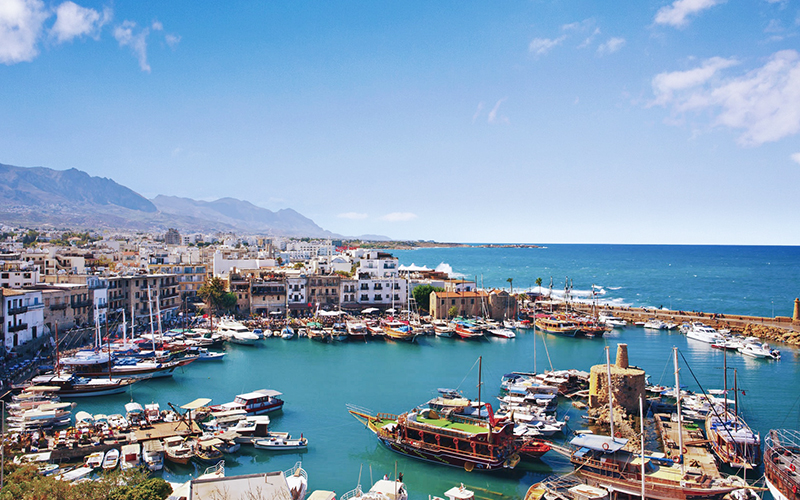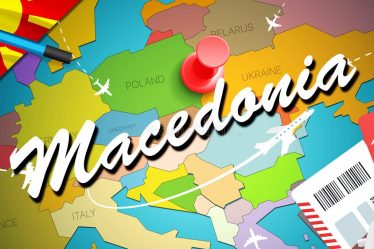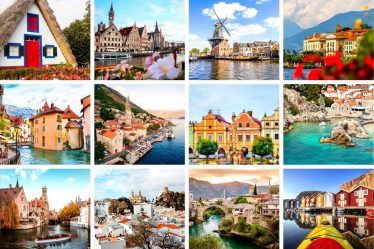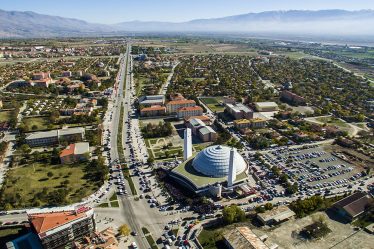
The Turkish Republic of Northern Cyprus (TRNC) is the third largest island in the Mediterranean. It is also known as Green Island, Baby Homeland or Paradise Island in Turkey. Located 65 km south of the Anatolian Peninsula, Cyprus has always been a desirable and attractive place in every period of history due to strategic, political, commercial and religious reasons.
Tourism, which is one of the biggest incomes of Northern Cyprus, which is an ideal holiday country with its magnificent Mediterranean view and beaches, has an important place in the country. The climate of the country is suitable for holidays all year round. Magnificent nature, endemic plant and animal species, beaches along the Mediterranean, a product of a richness blended with culture and history.

Information About Cyprus
Cyprus history
Cyprus cities
where is cyprus
Cyprus flights
Cyprus ferry
Cyprus visa
Cyprus traffic rules
Cyprus currency
Public holidays of Northern Cyprus
Cyprus climate
Information About Cyprus
The island of Cyprus is the birthplace of the mythologically beautiful Aphrodite, the Greek goddess of love and passion. Before rising to the rank of goddess, Aphrodite was born and raised on an island near Paphos (Paphos), the capital of western Cyprus.
In Nicosia, the meeting point of civilizations, and in Girne, the tourism pearl of the island, it is possible to come across the traces of all civilizations, from the Lusignans to the Venetians, from the Ottomans to the British. Cyprus is also home to archaeological remains such as many Roman castles, theatres, palaces and villas.
Cyprus history
Official Name : Turkish Republic of Northern Cyprus (TRNC)
Capital : Nicosia
National Anthem : National Anthem
Area: 3 thousand 355 km2 (36.5 percent of the island of Cyprus)
Management System : Semi-Presidential System
Official Language : Turkish
Currency : Turkish Lira (TL)
Population : 313 thousand 626 (2014)
Ethnicity : Turkish Cypriots
Religion: 99% Muslim, 1% Orthodox Christian
Time Zone : UTC+2, UTC+3 (summer period)
Telephone Code : +90 392
Internet Domain Name : .tr and .ct.tr
Traffic Flow : From the Left
Cyprus gained its independence by separating from England with the Treaty of Zurich in 1960. The Republic of Cyprus, which was established in 1960 under the guarantorship of Turkey, Greece and England, was a country where Turks and Greeks lived together and were represented at the rate of population in state institutions.
Since 1974 Cyprus has been divided into north and south. The reason why the island was divided into two is the military coup supported by the Greek government and the efforts to annex the island by Greece. As a result of the two peace operations carried out by Turkey using its powers as a guarantor country, the island was actually divided into two as north and south.
The Northern part of the island mostly belongs to Turkish Cypriots and the Southern part belongs to Greek Cypriots. The border line goes from Morphou to Nicosia and from there to Famagusta. The area called the green line separates the north and south under the supervision of the United Nations. The transitions between north and south are made in a controlled manner.
The southern part of Cyprus, which makes up two-thirds of the territory, is under the control of the Republic of Cyprus, which Turkey calls the Greek Cypriot Administration (GCA). The Republic of Cyprus is internationally recognized as the state representing the entire island. All of Cyprus is a de facto EU member.
The Turkish Republic of Northern Cyprus, on the other hand, is not recognized by any country other than Turkey in the international arena. The international community argues that the northern part of the island is occupied by Turkey and imposes an embargo on the TRNC. Officially established in 1983, the TRNC has a total coastline of 780 km. The most important settlements of the country are the capital Nicosia, Kyrenia, Gazi Magosa, Güzelyurt and İskele.
Cyprus cities
Kyrenia is a city that truly makes Cyprus live. Kyrenia Castle, whose every corner smells of history; Girne Harbor with its magnificent view and the best sea restaurants; Kyrenia welcomes its visitors with its many hotels for night entertainment and beautiful streets where a quiet life flows.
In Kyrenia Castle, one of the important museums of Cyprus, St. George Church and the Sunken Ship Museum. In the castle, which is about eight hundred years old, you can also see the reenactments of the Kirni Tombs, the Mediterranean Grave Excavation, the Venetian Tower built on the remains of the Early Byzantine period fortifications, the Lusignan Tower, and the cistern and dungeons built during the Lusignan period to meet the water needs of the castle.
The castle, which is about 800 years old, has a much older guest. The 2300 year old Girne Shipwreck from the Hellenistic period . As a result of the work that started in 1970, the merchant ship, which sank one mile off the Kyrenia Harbor as a result of a storm in 300 BC, when it was caught in the open sea, was preserved.
You can enjoy the wonderful view accompanied by the freshest seafood of the Mediterranean at the restaurants located around the port of Kyrenia. Bars and casinos in the harbor area, where night life is as lively as it is during the day, attract entertainment enthusiasts. Colony Hotel, which is a good holiday hotel, is my recommendation for those who want to stay in the city center of Kyrenia.

Kyrenia is one of the most mysterious and beautiful cities of the Mediterranean. Its location makes it feel like a very special city with its historical and natural beauties. A relaxing holiday in this city, where the touristic facilities are most concentrated, and accompanying it; historical harbour, Kyrenia Castle, Sunken Ship Museum, St. Hilarion Castle and Bellapais Monastery can be visited.
St. Petersburg, where the Lusignan kings were crowned as the King of Cyprus. Sophia Cathedral (Selimiye Mosque), the two-storey and 68-room Ottoman building, the Great Han, and the Venetian Column in the middle of Sarayönü square are among the places worth seeing. Nicosia, the capital of the TRNC, is the only divided capital of Europe. Greeks live in the south of the city and Turks live in the north.
Nicosia is the only divided capital city in the world, located in the middle of the island of Cyprus. The United Nations Peacekeeping Force is located in the intermediate zone called the Green Line of the city, which belongs to the Turks in the north and Greeks in the south. Since it belonged to the Turks for many years, it is possible to encounter characteristic Turkish works frequently in the city. Most of the places to visit in Nicosia are built in Turkish and Islamic styles.
If you are interested in the structures and events that have witnessed history in the places you travel, the Museum of Barbarism is for you. The museum is a small house that witnessed the Greek Massacres of 1963-1964 and was later converted into a museum.
For those who are curious about the historical life in Cyprus, it is a good decision to visit Derviş Pasha Mansion. This museum house, which was opened to visitors as the Ethnography Museum in 1988 after its interior was restored, is located in the Arabahmet Neighborhood, which preserves the historical environmental texture most intensely within the walls of Nicosia.
Selimiye Mosque, the largest place of worship on the island, was first built in St. It was built as the Sophia Cathedral. Later, the Ottomans added a minaret to the structure and turned the cathedral into a mosque. The historical Büyük Han is one of the largest inns in Cyprus and has an important architecture.
Lokmacı Gate, Kyrenia Gate and Nicosia Walls, Yiğitler Bastion Park are among the other places to visit in Nicosia.
Famagusta is located on the east coast of the island, between the headland of Poyraz (Greko) and Zeytin (Eloia). It falls to the east of Nicosia (Levkosia). The deepest port of Cyprus is within the city limits.
Venetian Palace: The Venetian Palace, whose history dates back to the 13th century, is a historical building located in Famagusta and attracting a lot of attention. The building, which was used as a royal palace when it was first built, was used as a residence by the kings until 1369. It is very easy to reach the Venetian Palace, as it is close to Namık Kemal Square in Famagusta.
Can Bulat Museum: The place where the tomb of Kilis Sancak Beyi Can Bulat, who played an important role in the conquest of Cyprus Island, is located, was previously known as the Can Bulat Bastion. This spot, where Sancakbeyi Can Bulat’s remains are located, was turned into a museum in 1968. The museum is right at the foot of the historical bridge that opens to the port of Famagusta. Can Bulat Museum has become one of the sightseeing places of tourists coming to Cyprus today. Next to it is the Famagusta Martyrdom.
st. Barnabas Monastery: Serving as the Icon and Archeology Museum, St. St. Barnabas Monastery, the son of a Jewish family born in Salamis and who wanted to spread Christianity. Built on the spot where Barnabas’ tomb is located, it was built in 477. The history monastery, which serves as a museum, is the museum with the largest area in the region. The monastery consists of a church and a courtyard and old parish chambers surrounding it on three sides.
Namık Kemal Dungeon and Museum: The historical building, located in the courtyard of the Venetian Palace, is known as the place where Namık Kemal was imprisoned in 1873. The building where Namık Kemal spent his exile is now open to visitors as Namık Kemal Dungeon and Museum. The museum, which attracts the attention of Cyprus visitors with the traces and historical texture of Namık Kemal, should be among the places you should see in Famagusta.
where is cyprus
Cyprus is located in the east of the Mediterranean, at the intersection of Africa, Asia and Europe. Cyprus, the third largest island in the Mediterranean after Sicily and Sardinia, is located 96 km west of Syria, 400 km north of Egypt’s Nile Delta and approximately 770 km southeast of mainland Greece.
Cyprus is located in the middle of multiple Middle Eastern countries such as Syria, Lebanon, and Israel. However, its closest border is with Turkey in the north. Cyprus, with its unique location, has been the scene of the struggle for sovereignty of different states and civilizations throughout history.
Cyprus flights
There are only direct flights to Northern Cyprus from Turkey. Cyprus flights are made from the international terminal of the airports. You can go to Cyprus through customs and identity or passport control. Ercan International Airport, which is 1 hour and 15 minutes’ flight away from Istanbul, is 40 km away from Kyrenia, the tourism and port city of TRNC. There are direct flights to Ercan Airport from Ankara, İzmir, Şanlıurfa, Trabzon, Adana, Antalya, Hatay, Gaziantep, Van and Samsun.

Cyprus ferry
Transportation to the Turkish Republic of Northern Cyprus by ferry from Turkey is made from Antalya and Mersin. Sea bus and ferry are used for sea transportation. Ferry services from Turkey to Cyprus are carried out mutually on the lines of Alanya-Girne, Taşucu-Girne, Mersin-Girne and Mersin-Famagusta. I explained more detailed information about transportation to Cyprus in my blog post on how to get to Cyprus ; look at.
Cyprus visa
No visa is required for touristic entry to Northern Cyprus. Citizens of the Republic of Turkey can enter Cyprus with an identity card. It is also possible to travel to the TRNC with a passport. Turkish citizens visiting the TRNC as tourists can stay in the country for a maximum of 90 days. Turkish citizens cannot cross from Northern Cyprus to the south. In order to visit Southern Cyprus, it is necessary to obtain a Cyprus visa from the Athens Embassy of the Greek Cypriot Administration.
Cyprus traffic rules
Traffic flows on the left in Cyprus, which has been under the influence of British culture for a long time. There are highway connections with other parts of the island and buses for public transportation. In Cyprus, where public transportation is not very common, the majority of the people have private vehicles. Taxi and car rental options are used by those visiting the country.
Cyprus currency
Northern Cyprus uses Turkish Lira (TL). As of January 1, 2008, the official currency of Southern Cyprus has been the Euro. Almost all banks can convert all commonly used currencies. Turkish Lira, Euro and Sterling can be used widely.
Public holidays of Northern Cyprus
1 January : New Year ‘s Day
23 April : Children’s Day
19 May : Youth and Sports Day
20 July : Peace and Freedom Day
1 August : Establishment of the Turkish Resistance Organization
30 August : Victory Day
29 October : Republic Day
15 November : Foundation of the Turkish Republic of Northern Cyprus
Cyprus climate
Cyprus has an intense Mediterranean climate with distinct seasonal characteristics. Summers are hot and dry, winters are rainy and highly variable. The average annual temperature of Northern Cyprus is 19 degrees, and the hottest month throughout the year is July. The air temperature in this month varies between 37-40 degrees in the shade. In January, which is the coldest month of the year, the daytime air temperature varies between 9-12 degrees.
Cyprus is one of the unique holiday centers of the Eastern Mediterranean, with its sea, nature, history, luxury accommodation facilities, colorful nightlife and casinos, which can be visited at any time of the year.


